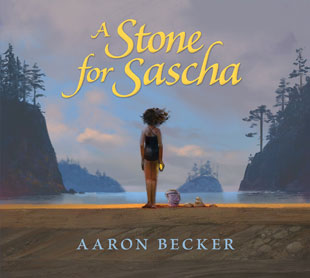This story benefits by being told entirely in wistful and powerful pictures. A young girl picks fresh flowers to put on the grave of the family's dog who has newly died. Her father's embrace of the bundle covered in a blanket of paw-print design and ready to be put in the ground, along with the girl's sorrowful embrace with her mother, says it all. She places her flowers on the grave and bows her head in silent grief.
Before the flowers have even wilted, the family leaves on vacation at a beach-front campground. The girl reaches into the water and finds a stone to skip, but as she does so, she looks into the heavens and sees a meteor shower. What happens next is awesome.
The illustrations suddenly carry us out into the cosmos, where we can view an approaching meteor as well as Earth from space. The two collide, and we realize we have been carried back in time to a stone's origin. As we pass through page after page, we travel through eons, with dinosaurs, rituals at standing stones, and various plunderings. People build a Buddha statue that incorporates a stone from the meteor; the next thing we know, it's carried off and carved into a box holding a dragon. As the story-in-pictures builds, our time frame becomes increasingly expansive, and with it our perspective does, too.
Finally, we wind up back at the shore, where the grieving girl has discovered a remnant of that long-ago meteor in the beach waters. When she brings it home, she finds a fitting way to honor her grief, now within a framework that's reverent and cosmic.
One of the fascinating aspects of this story is that we're never told whether Sascha is the girl's name or the dog's name. Is the stone for her, in consolation? Or for her dog, in commemoration? The fact that we don't know lets us imagine both, even as we consider the stone's epic journey that reflects the mystery of our own comings, goings, and other transformations.
